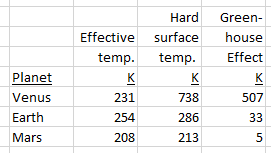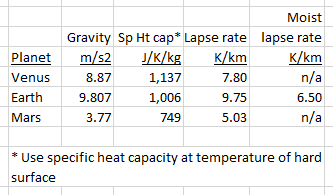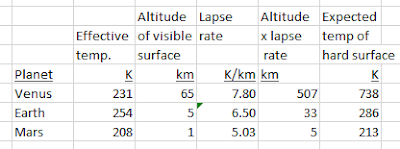ToGuest post by James Hansen.
-----------------------------
In the 1970s, I made up my mind that rising CO2 levels were the cause of rising temperatures. Nobody really knew whether this was cause-and-effect (and if so, which causes which); correlation (a third factor causes both); pure coincidence; or just one of those things we'll never be able to explain - maybe these warmer phases come every thousand years or so (Roman warm period, Mediæval warm period, Modern warm period...), but I decided to stake my career on it.
I didn't have much evidence - at the top of page 1, column 2, I clearly stated "The major difficulty in accepting this theory has been the absence of observed warming coincident with the historic increase. In fact, the temperature in the Northern Hemisphere decreased by about 0.5C between 1940 and 1970; a time of rapid CO2 buildup." (my children call this a 'spoiler'; my grandchildren call this a 'clue bat'), so I twisted the facts to fit my logic. I did a Diagonal Comparison, reversed cause and effect and then covered my tracks a bit by using technical jargon.
There is of course a Greenhouse Effect. Broadly speaking, all else being equal, the thicker the atmosphere, the warmer the hard surface will be. The atmosphere is like a blanket. It warms up and cools down slowly, it keeps the hard surface a bit cooler by day time and a lot warmer by night. Surely people can work this out intuitively? What the atmosphere's constituent gases are is pretty irrelevant, all that really matters is their specific heat capacity (which is not much different for nitrogen, oxygen or CO2 - see below). Ozone is a special case (that actually does have an effect). But 'Greenhouse effect' is neat shorthand, so I hijacked the term and made up my own explanation for it.
Luckily, CO2 levels and temperatures have continued rising since my 1981 essay, so everybody heralds me as a visionary genius and assumes that my logic was sound. I'm really surprised that nobody ever noticed the sleights of hand, not even those we deride as Climate Skeptics or dismiss as Science Deniers who are out to debunk it all.
Nonetheless, like any great showman at the end of his career, I now want to tell the world how I did it (not least because regular commenter Dinero posted a link to my original essay here, and our blog host saw straight through it and will blow the gaff if I don't do it first).
Start with some basic physics and maths
As any physicist knows, you can calculate the expected temperature of the visible surface of a planet by working out the average amount of solar radiation each m2 gets from the Sun (over the planet's day); deducting the amount that is reflected back to space; dividing that by the Stefan-Boltzmann Constant (5.67/10^8); taking the fourth root of the result; and that's your temperature in degrees K.
Here are the workings:

The Stefan-Boltzmann Constant is derived from observation and trial and error; you can tweak the figure for albedo a bit (nobody knows the exact values) and so of course it all stacks up and is a good match for measured temperatures.
Don't forget that we take (white) cloud cover into account when calculating how much radiation is reflected straight back to space, so the end-result of our calculations is the expected temperature of the cloud cover (to the extent that the planet has cloud cover) at that altitude (i.e. the altitude of the visible surface)...
- The altitude of the visible surface of Venus is 65 km, the mid-point of the cloud cover, which is between 50km and 80 km altitude.
- The average altitude of the visible surface of Earth is 5 km altitude. Earth's visible surface is two-thirds cloud cover, mainly in the upper half of the atmosphere - effective altitude 7.5 km - and one-third hard surface or open ocean - altitude zero - so the overall weighted average altitude of the visible surface is at an altitude of approx. 5 km.
- The average altitude of the visible surface of Mars is 1 km. Mars has very little cloud cover, but there are dust storms. On average, the visible surface is barely above the hard surface, call it 1 km for sake of argument.
Of course, simply referring to this as "the expected temperature of the visible surface, be that cloud cover or hard surface, at the average altitude of the visible surface" would have made the next logical leap too transparent, so I used the term "effective temperature" instead, a term whose meaning is not immediately obvious.
Trick 1 - the Diagonal Comparison
Having shown that I can plug numbers into equations and get the right answer, I then did a Diagonal Comparison. I compared the temperature of the visible surface (at a high altitude, now referred to as "effective temperature") with the actual measured hard surface temperature (at zero altitude) and called the difference 'The Greenhouse Effect', which I explained with the hand wave "the excess... is the greenhouse effect of gases and clouds".
It's like a green grocer telling you that potatoes are more expensive than tomatoes, because 1 lb of tomatoes costs $1, but 5 lbs of potatoes costs $1.50!

Luckily, most people just stop reading here. They put 2 and 2 together to make 507. The atmosphere of Venus is 95% CO2, so my followers talk about "the runaway Greenhouse Effect" and sound plausible. In truth, if you follows the basic maths and physics outlined below, 2 plus 2 still makes 4. There's no geometric effect, and not even a logarithmic effect (Heaven only knows why the Skeptics set off on that road).
Some more basic physics and maths
Having established the expected temperature at a certain altitude, it's not difficult to estimate the temperature of the hard surface and to get your estimate to match up to measured temperatures.
The atmosphere gets cooler the higher up you go; which is another way of saying that it gets warmer as you descend to ground level. This is the lapse rate (which we insiders call 'adiabatic lapse rate' to sound clever). The lapse rate is actually easy to work out. You just have to understand that the kinetic energy (heat) in air lower down is converted to potential energy as it rises (and vice versa); heat is 'used' to lift the air, which gives it more potential energy (and vice versa as it descends). You calculate the lapse rate as gravity ÷ specific heat capacity of the air.
How to work out the lapse rate:

[What tickles me here is that I openly admitted that water vapour and clouds reduce the lapse rate by one-third. To quote from my 1981 essay "The [moist] lapse rate is less than the [predicted] value because of latent heat release by condensation as moist air rises and cools". That part is actually true - moist air releases heat as it cools - but I explained it so briefly that most people would either not understand it or ignore it
Now that my followers have been forced to admit that the effect of CO2 must be far lower than they want it to be, they are falling back on the Positive Feedback effect of water vapour (and ignoring the inevitable clouds, which more than cancel it out).
Even better, the table shows that the lapse rate on Earth is slap bang in the middle of the lapse rates on Venus or Mars, even though "the atmospheric composition" on Earth is completely different to that on Venus or Mars. Which is why I didn't include that table in the essay, duh.]
Finally, you estimate the expected hard surface temperature. You start with the estimated effective temperature from above; multiply the lapse rate by the altitude of the visible surface; and add them together. Stands to reason - the thicker the atmosphere (and lower the hard surface is relative to the cloud cover), the higher the temperature at the hard surface. Not even the most hardened Skeptic or Denier disagrees on this; it's common sense. The end results are very close to measured temperatures (unsurprisingly, because you can tweak all the variables a bit):

Trick 2 - reversing cause and effect
Of course, using the proper chain of logic and cause and effect (as above) would have given the game away, so I reversed the logic and swapped cause and effect - I had to show that a higher hard surface temperature led to less radiation going into space (seriously, I'm surprised anybody fell for this).
To quote from my seminal work again, "The mean surface temperature [on Earth] is 288 K. The excess ['effective temperature' less hard surface temperature] is the greenhouse effect of gases and clouds, which cause the mean radiating level to be above the surface... the atmospheric composition of Mars, Earth and Venus lead to mean radiating levels of about 1 km, 6 km and 70 K and lapse rates of 5K/km, 5.5 K/km and 7 K/km*"
(* the current agreed values differ slightly, but I deserve credit for being pretty close).
You note that this is where I circle back to "greenhouse gases" out of nowhere, adding the vague phrase "the atmospheric composition", even though the entire trail of physics so far clearly shows that the only thing that matters is their specific heat capacity and the lapse rate is barely affected (see above).
If you read my essay properly, you'll see that I started with the temperature of the hard surface and subtracted a lapse rate* to arrive at the temperature at the altitude of the visible surface, which in real life is the first thing you work out, not the last. The figures 1 km, 5 km and 70 km are our starting points for the calculations, not the end results! In the US, we call this "arse backwards", I believe you Brits call it "arse over tit".
* It's also it's nonsense to work out the lapse rate the way I did, by dividing the altitude of the visible surface by the difference in temperature between hard surface and visible surface. You can work out the lapse rate independently (see above) and then you multiply that by the altitude, etc. On either side of The Pond, that's called a circular calculation and Excel will give you an error message.
It's like a green grocer saying, "Well, 5 lbs of potatoes cost $1.50, so the price for 1 lb must be 30c", when in fact, he decides the price per lb first; you tell him how many lbs you want to buy; and then he works out the total price in $.
Covering my tracks
I referred to the altitude of the visible surface (i.e. the cloud cover, which anybody can understand) as "mean radiating level" and/or "the flux-weighted mean altitude of the emission to space". Why use an easily understandable concept if an impenetrable one will do?
What also amazes me, looking back, is that nobody noticed that although I was using the equation for estimating the temperature of the cloud cover based on solar radiation coming in (the common sense approach), I passed it off as the equation for working out the temperature of the layer which radiates back to space (and which is conceptually more difficult).
I started the section headed Greenhouse Effect as follows "The effective radiating temperature of [a planet] is determined by the need for infrared emission from the planet to balance absorbed solar radiation". I then gave the long version of the equation for working out the former (which insiders can immediately recognise) and said it was the equation for working out the latter (which outsiders will take at face value. The two equations are the same, you just reverse cause and effect).
Well of course the temperature of the layer that absorbs radiation is the same as the temperature of the layer than emits radiation - it's the same layer! But it distracted people from the fact that I had wasted two whole columns explaining how to work out backwards how high the cloud cover is (to the extent that a planet has a cloud cover), which is easy, you just measure it!
In practice, most of the cloud cover is most of the top half of the troposphere, on Earth as it is on Venus (the dust clouds on Mars are more at surface level). I admitted as much in page 2, column 3: "Study of Venus suggests that some clouds occur at a fixed temperature. The Venus cloud tops, which are the primary radiator to space; are at [the altitude of] 70 km, where the [actual measured temperature = the expected temperature]". .
So really, what I said was "the cloud cover is at 70 km because the cloud cover is at 70 km". But I had the good sense to squeeze in some pseudo-scientific babble in between and/or gamble on nobody reading that far.
You don't believe me?
Now I've explained how I did it, just re-read page 1, column 3 and page 2, column 1 of my 1981 essay and see if you can spot how I papered over the cracks:
http://climate-dynamics.org/wp-content/uploads/2016/06/hansen81a.pdf
(copy that URL into your browser, I'm too old for hyperlinks).
Please don't kick yourselves too hard, a whole generation of scientists and 'activists' fell for it as well!
With best wishes,
James Hansen
PS, if you have any questions, please write to me at:
James Hansen
c/o Climate Science, Awareness and Solutions
Earth Institute, Columbia University
475 Riverside Dr. Ste 401-O
New York, NY 10015
